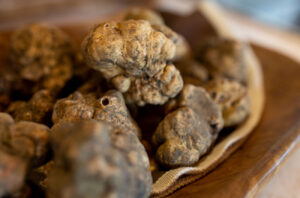The Istrian peninsula – the largest in the Adriatic – has for centuries been a meeting point of cultures and linguistic identities. Today, the vast majority of Istria lies within Croatia, with a small area in Slovenia and an even smaller one within Italy. Its history includes periods as part of Yugoslavia, Italy, the Austro-Hungarian Empire, the Venetian Republic and more.
These layers of history have lent the region a complex identity and a unique gastronomic heritage. Food culture and a pride in the produce of the land are a key part of this identity. Treasured wild asparagus is foraged from Istria’s pine and cedar woodlands, and Istrian truffles, both black and white are served at Michelin-starred restaurants worldwide. From forest floor to gourmet dishes, Istria’s prized truffles offer a glimpse into the region’s history – and take pride of place in its local cuisine.
Discover more about the world of Istrian truffles
On the Istrian truffle trail
Truffles have been treasured for millennia, from ancient Mesopotamia to Greece and Rome. Why are they such a source of fascination? Is it their humble, unglamorous exterior, belying the exquisite flavour within? Perhaps it’s the adventure it takes to find them – accompanied by a truffle hunter and the keen nose of a four-legged companion.
Istria is home to the most coveted of white truffles – the tuber magnatum pico – as well as three varieties of earthy black truffles. And although they were once the preserve of nobility, prized by the area’s past Venetian and Austro-Hungarian rulers, today any visitor to Istria can experience the traditional truffle hunt – not to mention the bounty unearthed.

Istria is home to the coveted tuber magnatum pico white truffle. Credit: Domagoj Sever.
Hunting in Istria’s truffle triangle
The area of northern Istria between the towns of Buzet, Pazin and Buje is known as the ‘Truffle Triangle’. The moist, clay-rich forests of Motovun-Montona, along the Mirna river, are a prime location, and in 1999 yielded what was then the largest white truffle ever found.
Istria’s white truffles can reach the size of a large apple, and can be found from late summer to early winter. October is the peak white truffle season – and a great time to visit, as the region comes alive with festivities in its honour. Local black truffles can grow even larger than their white counterparts and are harvested throughout the winter.

Fresh pasta is the perfect match for aromatic and delicious truffle shavings. Credit: Julien Duval.
From forest to plate
Once found, the complex truffle is a simple thing to enjoy. The revered white variety is eaten just as nature intended: raw. Local chefs crown dishes with a tumble of freshly shaved truffle, releasing its heady aroma into the air and its inimitable flavour onto the plate. The black truffle might be less rare, but it is no less cherished in local cuisine.
There is an entire canon of Istrian truffle dishes to be discovered – from cheeses like ovčji sir tartufima, preserving the season’s delight for the rest of the year, to fresh pastas like folded fuži or hand-rolled pljukanci, shaped perfectly to catch creamy, truffled sauces. The traditional mainstay of the truffle hunter, however, is the everyday omelette, dressed with a just-found truffle – and just like that, elevated into something quite sublime.
Discover more about Istria
Connect on
Facebook | Instagram | X | YouTube








